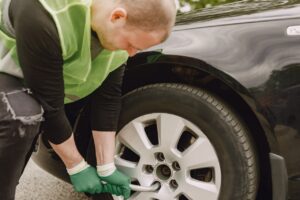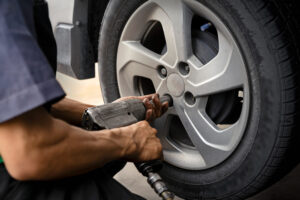Cary’s frequent downpours can make even short drives feel risky when your tires struggle to grip the road. We at Agile Towing Company often hear from local drivers facing these challenges, especially during wet months. This guide explores how Cary’s humid, rainy climate leads to tire issues like hydroplaning or pothole damage, with tips for wet-weather driving and seasonal checks. We’ll cover weather patterns, common problems, prevention strategies, and steps to take if trouble hits. If you need mobile flat tire or roadside support in Cary, reach us at (919) 276-5900.
Understanding Cary’s Weather Patterns and Their Impact on Tires
Cary sits in a humid subtropical zone, with about 45 inches of rain each year, according to local weather data. Summers bring heavy thunderstorms, while spring and fall see steady showers. These patterns directly affect your tires in ways that build up over time.
High humidity keeps moisture in the air, which seeps into tire materials and weakens them. Rain creates standing water on roads, reducing traction. Temperature swings, from 90-degree highs to 40-degree lows, cause tire pressure to fluctuate. For instance, a 10-degree drop can lower pressure by 1 PSI, making tires feel soft and less responsive.
In Cary, roads like those near Lake Crabtree often flood after storms, amplifying these effects. Over time, this wear leads to bigger issues, such as cracks or uneven tread. Recognizing these patterns helps you prepare and avoid surprises on your daily routes.
Common Cary Weather Tire Problems and Warning Signs
Weather in Cary brings specific tire challenges that drivers notice more during rainy periods. Let’s break down the main ones, along with signs to watch for.
Hydroplaning and Wet Road Hazards
Hydroplaning happens when water lifts tires off the pavement, causing loss of control. In Cary, where rain can hit 2 inches in an hour during storms, this risk rises on highways like I-40.
Look for these warning signs: a sudden floating feeling in the steering wheel, squealing sounds from tires, or the car pulling to one side. If your anti-lock brakes activate without reason, it could signal early hydroplaning.
Pothole Damage from Rain and Freezes
Rain erodes Cary’s roads, and winter freezes expand cracks into potholes. The town reports hundreds of pothole fixes annually, especially after wet seasons.
Signs include a loud thump when hitting a bump, vibrations at higher speeds, or visible dents in the tire sidewall. Uneven tire wear often follows, showing as bald spots.
Tire Pressure Issues in Humid Conditions
Humidity and heat make tires expand, while cooler, wet weather causes contraction. This leads to underinflation, common in Cary’s variable climate.
Warning signs are a lit tire pressure monitoring system light on your dashboard, sluggish handling, or increased road noise. Check pressure if your car feels less stable in rain.
These problems tie into Cary weather tire problems, where moisture and temperature shifts create ongoing stress on your tires.
Prevention Tips: How to Protect Your Tires During Cary’s Rainy Season
Rainy season tire safety starts with proactive steps. Cary’s peak wet months, from April to October, demand extra attention to keep tires in top shape.
- First, measure tread depth regularly. Use a quarter: insert it into the groove with Washington’s head down. If the top of his head shows, your tread is below 4/32 inches and needs replacement for better wet grip.
- Maintain proper inflation. Check pressure every two weeks during rainy periods, aiming for the level in your vehicle’s manual, typically 30-35 PSI for sedans. Local gas stations in Cary often have free air stations.
- Choose tires suited for wet conditions. All-season tires with deep grooves work well here, offering good hydroplaning prevention. Rotate them every 6,000 miles to ensure even wear.
- Drive smarter in rain: reduce speed by 10 mph on wet roads, avoid sudden brakes, and steer clear of puddles. After driving through water, tap brakes lightly to dry them.
- For hydroplaning prevention tips, focus on smooth actions. Keep a safe distance from other cars, and scan ahead for shiny, wet patches that signal potential slips.
These habits reduce risks and extend tire life, making your commutes smoother.
What to Do If Weather-Related Tire Problems Strike
Sometimes, despite precautions, Cary’s weather catches you off guard. If you suspect a tire issue, act quickly to stay safe.
- Pull over to a well-lit spot if possible, away from traffic. Turn on hazard lights and stay inside the vehicle on busy roads like Davis Drive.
- Assess the problem: check for visible damage like cuts or low pressure using a gauge from your glove box. If it’s a minor leak, a portable inflator can provide a temporary fix.
- For serious issues, like a blowout from a pothole, avoid driving further. That’s when professional help matters.
- Carry essentials like a spare tire, jack, and flashlight in your trunk for basic readiness.
Know when to call: if the tire is flat, damaged beyond a quick patch, or if weather makes DIY unsafe. In Cary, response times for such services average 30-45 minutes.
FAQ: Quick Answers to Cary Weather Tire Problems
What causes hydroplaning in Cary’s rain?
It occurs when water builds up between tires and the road, often on poorly drained streets after heavy showers. Slow down and maintain tread depth to prevent it.
How does humidity affect tire pressure?
High humidity paired with heat can cause overinflation, while cooling leads to drops. Check pressure weekly during Cary’s humid summers.
Are all-season tires enough for Cary’s rainy season?
Yes, for most drivers, as they handle wet conditions well. Upgrade to rain-specific tires if you drive often in storms.
Wrapping Up Your Rainy Season Tire Strategy
Cary’s weather brings unique tire challenges, from hydroplaning risks to pothole damage, but understanding them helps you stay ahead. Focus on regular checks, smart driving, and timely prevention to navigate rainy seasons safely.
We at Agile Towing Company are part of the Cary community, ready to assist with weather-related tire needs. Reach us at (919) 276-5900 for reliable support. With these tips, you’ll handle local conditions with confidence and keep your drives worry-free.



